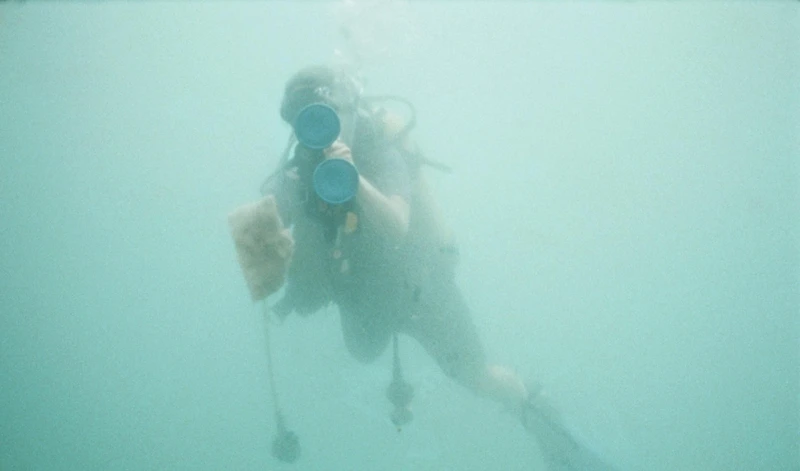Adaptation – Life before, with, after us
25 Feb-22 Apr 2022
PV 25 Feb 2022, 6.30-8.30pm


A season of artist films convened around the theme of ‘adaptation’. Looking at our increasingly precarious relationship with the environment and non-human animals the films in Adaptation ask several urgent questions: What might we learn from imagining the planet's ecology at a macro- and micro-scopic scale, placing ourselves in the vast web of multi-species interconnectedness? What are the long-term consequences of our abuse of the planet and is our compulsion to intervene, mend and repair in fact tied to a deeper desire for dominion over nature, serving only to cause further damage? Is it now us who must adapt to survive in the fragile niche we have created, and, if it is in fact too late, what might the world look like when we are all but extinct?
In an unmoored, ascending temporal scale the works take the viewer from pre-human, deep geological time – meditating on things in the natural world so small they fall outside our comprehension, yet our very existence depends on them – to a post-anthropogenic future in which a possible last person on earth clings to life in a dying ecosystem.
Keira Greene – Eustatic Drift – 8mins 37secs
“Once we were plankton slouched in the ocean but now we are code, surfaced and held in the laminae of rock like open scores” This narrative voice comes to us from the fossils of Graptolites, our long extinct plankton ancestry. Their speculative voice speaks to us from within deep time as they coil past and future, blending evidence of our interspecies story. In Eustatic Drift we experience the real and imaginary potential of the Graptolites, as a tangible index of a once dominant species, and as a latent oracle. The film opens with wide images of the remote landscape of Dobs Linn, Scotland, significant for its graptolite-bearing strata. The landscape is richly complex in these singled out moments, held at a distance. History is sunk into the fabric of the rock and at the same time in constant change; change is its constant truth. The landscape is cut with images of the fossils; they remind us of the certainty that everything is vulnerable, of trauma that has lost all meaning, but the Graptolites present a post literative world, in which language and hybridity must evolve. In a studio environment dancer Katye Coe performs the Graptolite as an open score. She unfolds the rock and imagines how the species may’ve moved. In one instance we read in their script: “perhaps we were swimming?” Coe’s performance bears resemblance to the development of a seedling in the dark. She draws upon the depth of our interspecies memory in the absence of scientific knowledge as to how the Graptolite species moved or how deep in the Ocean they lived. In Eustatic Drift the camera meditates on the surface of images, preoccupied with that which runs beneath “there and not there”. What is immanent to the Graptolite? What is rooted in the dialectic of an embodied experience, that is critical to all species? Eustatic Drift addresses a growing consciousness that our interaction with other species is critical for human survival.
Ellie Kyungran Heo – Plantarians – 32mins 47secs
An English-style garden, a plot of earth in New York’s Central Park, a garden and a cemetery in Maastricht: Plantarians asks, ‘what does it mean to have a garden?’ Divided into episodes, the film studies the capacity of garden plants to respond to the particularities of their surroundings; at the same time, it tracks the lives of the contemporary men and women who cultivate, enjoy, eat, obsess over, and even grieve with and for these plants.
Maeve Brennan – Listening in the Dark – 43mins 30secs
Listening in the Dark (2018) gathers a series of subtle but penetrating soundings of human beings’ impact on the natural environment. While there is a growing sensitivity to the ecological damage we are causing, we can also be strangely blind to things that happen outside of our consciousness. A creature that has often fallen beneath our radar is the bat. Undisturbed, and largely unchanged, for millions of years, its nocturnal rhythms are being increasingly interrupted by the presence of wind turbines. Taking the interaction between bats and wind turbines as its starting point, the film traverses geological, ecological and human time spans to navigate the complexity of the Anthropocene.
Ben Rivers – Urth – 20mins
The last woman on Earth. Filmed inside Biosphere 2 in Arizona, Urth forms a cinematic meditation on ambitious experiments, constructed environments, and visions of the future. Writer Mark von Schlegell contributes a text-read as the final log instalments of a woman sealed inside an unforgiving environment. The film considers what an endeavour such as Biosphere 2 might mean today and in the near future, in terms of humankind’s relationship with the natural world.